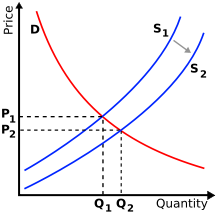The effects of immigrants in the host country

Here is an oversimplified vision of immigration: a substantial number of foreign unskilled workers enter the job market, causing a shift of the labor supply curve to the right (workers are suppliers of work), and changing the current equilibrium to another one with lower wages. This is does not need to be the case. Immigrants may also be entrepreneurs, adding also to the demand, and skilled workers may add to the human capital of the recipient country, and create complementarities with native workers. Here I summarize a recent article by Giovanni Peri (2016) 1 (often with his own words) that overviews the studies on immigration that take all these complications into account.

The facts of immigration for the USA, Western Europe, Canada and Australia do not obey the stereotype. In these rich regions there has been a similar growth of foreign-born as share of the population with an increase by 8-9 percentage points of the population from 1960 to 2015, or about 0,2 percent per year. Since 1990 most immigrants come from non rich countries that are not the poorest in their regions. Emigration to high-income countries is better described (as in Clemens 2014 2) as a phase in the economic development of a country rather than an escape valve for countries most deeply mired in poverty. However, the most striking fact about immigration is that the composition of immigrants tends to be more educated not just relative to other people in their countries of origin, but also relative to the country of destination (Docquier and Marfouk 2004 3; Docquier, Lohest, and Marfouk 2005 4). This is most likely due to the fact that the benefits from emigration are higher for those individuals. Finally, immigrants tend to locate in cities, where they could be contributing to human capital agglomeration and density externalities.
To analyze the immigrants’ effects on the host country, it would be useful to consider separate groups according to their skills. A first relevant distinction is to consider “college-educated” and “non-college-educated”. In the USA the inflow of immigrants has been balanced between these two groups. Furthermore, in 2014 the percentage of foreign born among the US workers without and with a college degree was 16.9 and 16.1, respectively. These facts have two implications. First, because of the similar composition of these two groups, immigration would not have much effect on their relative wages. Second, because of the immigration is constant and steady, capital could adjust easily (as it adapts to a steady growth in population), so absolute wages should have remained stable in response to immigration.
A more detailed distinction separates the group of non-college-educated workers in subgroups, depending on the performance of manual or non-manual tasks. Now we find a relevant difference in the composition of these subgroups, with a percentage of foreign-born workers of 18 and 32, in the most and less manual subgroups, respectively. College educated workers, on the other hand, can be separated in those performing math-analytical tasks, where immigrants are concentrated, and those performing managerial-communication tasks. Theoretically these differences in composition imply that wages in both manual and math-analytical tasks would decrease, while, through complementarity, they would also generate an increase in the wage of non-manual and non-math-analytical occupations, which would disproportionately benefit native workers. Manual abilities are transferrable across countries but communication abilities (especially if native languages are different) are much harder to transfer. For college-educated immigrants, math-analytical skills are more easily transferred across countries than managerial and communication skills, which are more culture and country specific.
A further implication of the abovementioned differences and complementarities is that native workers will move away from task/skills supplied by immigrants and towards tasks/skills complemented by them, either by changing their educational choices or by moving to occupations that specialize in the abilities for which natives have a comparative advantage. This move will enhance the complementarities and reduce competition between immigrants and natives (Peri and Sparber 2009 5 study the effect for non-college educated workers and Peri and Sparber 2011 6 do the same for college educated workers.) These moves are not the only possibilities, as native workers may react with geographic mobility or with adjustments at the firm level.
Empirical evidence
For empirical studies that focus on skill and structure a good option is to divide workers by education and simulate a general equilibrium economy to estimate the effects of incoming workers. This is better than the alternative that uses partial equilibrium analysis (focusing on one type of workers at a time), as it take into account cross-effects between groups. Ottaviano and Peri (2012) 7 analyze the effect for 1990–2006, finding a positive impact between 0.3 and 0.6 percent on wages of native non-college workers and ranging from 0.3 to 1.3 percent for college-educated workers.
When the focus is on adjustments and identification, the research strategy is to identify two cities (or two groups of cities), one with previous immigrants of the same nationality, and the other without it. Immigrants tend to go to the first city for non economic reasons, so we can study the differences between the two cities to assess the effects of immigration. Ottaviano and Peri (2006) 8 estimated a significant positive effect from increased immigration on labor productivity, especially if immigrants are from a variety of countries of origin. These studies observe some specific European features: small wage effects and possibly some negative employment effects on natives and a somewhat smaller response of native specialization (for example, D’Amuri and Peri 2014 9, and Glitz 2012 10), perhaps due to lower labor flexibility. There seems to be a certain amount of “skill downgrading” of immigrants so that workers with relatively high schooling level perform jobs comparable to less-skilled natives. This is likely due to barriers created by language, licensing, and legal requirements.
Another source of data is available when a region receives a sudden inflow of immigrants for causes other than economic circumstances in the region. This happens, for instance, when a city, province or state receives a large number of refugees. (A previous article in mapping ignorance reported some cases.) Although Peri (2016) [1] finds these cases an unreliable source of data, the best studied cases report a positive effect on native wages. This is true for the Mariel boatlift and for the surge in refugees to Denmark from the war zones of Bosnia, Somalia, Afghanistan and Iraq. In accordance to the previously stated hypothesis, the explanation for this wage increase is that native low-skilled workers made a transition towards less manual and more complex (communication- and cognitive-intensive) occupations in response to the inflow of refugees, who specialized in manual jobs, and this increased their wages.
Promising research avenues
The experience gained with the latest empirical studies on the effects of immigrants on the labor markets suggest three research lines:
-Pay closer attention to the details of immigration policies.
-Exploit the differences on labor flexibility in European labor markets, and on policies and institutions.
-Study the still not well understood connection between high-skilled immigrants, and technological and scientific progress.
References
- Peri, G. 2016. Immigrants, Productivity, and Labor Markets. Journal of Economic Perspectives 30:4, 3-30. ↩
- Clemens, M.A. 2014. Does Development Reduce Migration? IZA Discussion Papers 8592, Institute for the Study of Labor (IZA). ↩
- Docquier, F., and Marfouk, A. 2004. Measuring the International Mobility of Skilled Workers (1990–2000): Release 1.0. Policy Research Working Paper 3381, World Bank. ↩
- Docquier, F; Lohest, O., and Marfouk, A. 2005. Brain Drain in Developing Regions (1990–2000). IZA Discussion Papers 1668, Institute for the Study of Labor (IZA). ↩
- Peri, G, and Sparber, C. 2009. Task Specialization, Immigration, and Wages. American Economic Journal: Applied Economics 1:3, 135–69. ↩
- Peri, G., and Sparber, C. 2011. Assessing Inherent Model Bias: An Application to Native Displacement in Response to Immigration. Journal of Urban Economics 69:1, 82–91. ↩
- Ottaviano, G.I.P., and Peri, G. 2012. Rethinking the Effect of Immigration on Wages. Journal of the European Economic Association 10:1 152–97. ↩
- Ottaviano, G.I.P., and Peri, G. 2006. The Economic Value of Cultural Diversity: Evidence from US Cities. Journal of Economic Geography 6:1, 9–44. ↩
- D’Amuri, F., and Peri, G.. 2014. Immigration, Jobs, and Employment Protection: Evidence from Europe Before and During the Great Recession. Journal of the European Economic Association 12:2, 432–64. ↩
- Glitz, A. 2012. The Labor Market Impact of Immigration: A Quasi-Experiment Exploiting Immigrant Location Rules in Germany. Journal of Labor Economics 30:1, 175–213. ↩